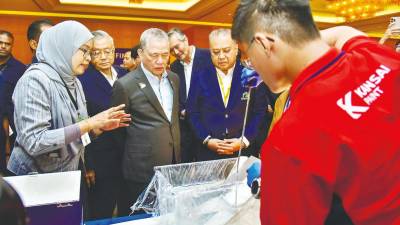PETALING JAYA: The government will conduct a feasibility study on nuclear energy, including small modular reactors (SMR), to assess its potential as a stable base-load power source for regions where renewable deployment faces unique challenges.
Depuyy Prime Minister and Energy Transition and Water Transformation Minister Datuk Seri Fadillah Yusof said this study will evaluate waste management strategies to ensure nuclear energy is integrated responsibly into Malaysia’s sustainable energy ecosystem.
“We are assessing existing technologies in terms of safety, safeguards, and security to determine what is best for Malaysia. Public engagement and acceptance are critical, as only with their support can this nuclear energy initiative move forward.
“Encouragingly, industry feedback has been very positive, with many urging us to accelerate the nuclear energy process,” he told reporters at the International Green Build Conference 2025 ( (IGBC 2025) today.
Fadillah said from a regulatory perspective, the government’s focus extends beyond compliance to building the right human capital. This involves not only developing technological expertise but also strengthening enforcement capabilities, which must be seen as a priority, he added.
“Of course, there are international commitments to consider. Malaysia must align with 18 international treaties and agreements – including several with the United States – before we can finalise a decision on nuclear energy.
“Only then can we determine whether nuclear energy will become part of our future energy mix,” Fadillah said.
Touching on Sabah’s energy demand and nuclear energy potential, Fadillah said the government must assess the preconditions.
“In Sabah, energy resources are limited. The state does not have significant hydro or solar capacity, and while battery storage, biomass, and biogas can play a role, these sources are also limited. Therefore, we need to identify other firm energy options that can provide a reliable base load for Sabah and the wider region.”
Fadillah said any decision must be based on meeting key preconditions. This includes securing public acceptance, ensuring regulatory frameworks are firmly established, and addressing all necessary requirements before moving forward.
“The final decision on the exact location for the SMR cannot be made until these preconditions are satisfied. Only after the base framework is finalised can we proceed with the Environmental Impact Assessment and confirm the certainty of location for the SMR,” he added.
Apart from nuclear energy, Fadillah said, the government will launch the National Energy Efficiency Action Plan 2026-2035, a comprehensive strategy that will chart initiatives across all sectors to drive energy savings, encompassing both electrical and thermal energy measures.
“Our efforts are firmly anchored in the 13th Malaysia Plan (RMK13), which identifies sustainability and green growth as national priorities. RMK13 outlines specific targets, including increasing renewable energy share in the national mix to 35% by 2025, improving energy efficiency across all sectors, and promoting green building certifications such as GreenRE,” he added.
Fadillah said the government recognises that green electricity is a key enabler of future economic growth and development.
He nioted that the National Energy Transition Roadmap has set out a pathway to achieve 70% installed renewable energy capacity by 2050. This includes the accelerated deployment of large-scale solar projects, expansion of biomass and biogas utilisation, and exploration of emerging renewable technologies such as hydrogen.
“Petra (Energy Transition and Water Transformation Ministry) is committed to working hand in hand to create a sustainable, resilient, and prosperous Malaysia. Let us seize this opportunity to drive transformative change in the built environment and contribute to a greener, more sustainable world for generations to come,” Fadillah told IGBC 2025 delegates and participants.
